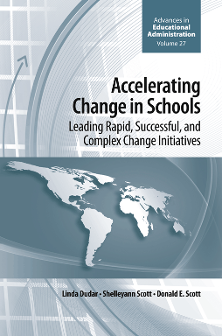
Index
Accelerating Change in Schools: Leading Rapid, Successful, and Complex Change Initiatives
ISBN: 978-1-78635-502-7, eISBN: 978-1-78635-501-0
ISSN: 1479-3660
Publication date: 16 March 2017
Citation
Dudar, L., Scott, S. and Scott, D.E. (2017), "Index", Accelerating Change in Schools: Leading Rapid, Successful, and Complex Change Initiatives (Advances in Educational Administration, Vol. 27), Emerald Publishing Limited, Leeds, pp. 327-335. https://doi.org/10.1108/S1479-366020160000027022
Publisher
:Emerald Publishing Limited
Copyright © 2017 Emerald Publishing Limited
INDEX
- Prelims
- Section I – Leadership and Rapid Change
- Chapter 1 The Demand for Rapid Change
- Chapter 2 Understanding the Theory of Change Processes
- Chapter 3 Stakeholders and Change Participants – Important Influencers
- Chapter 4 Defining Change Leadership
- Chapter 5 The Self-Aware and Discerning Change Agent
- Chapter 6 The Rapid Change Model
- Section II – Rapid Change: Success Stories from Educational Leaders
- Chapter 7 The Head and Heart of Change: Leaders’ Advice about Change
- Chapter 8 Leaders’ Success Stories of Culture (People) Change
- Chapter 9 Leaders’ Success Stories of Program Change
- Chapter 10 Stakeholders Are Important Too!
- Chapter 11 Context is Interesting and Important
- Chapter 12 Are You Ready?
- About the Authors
- References
- Index